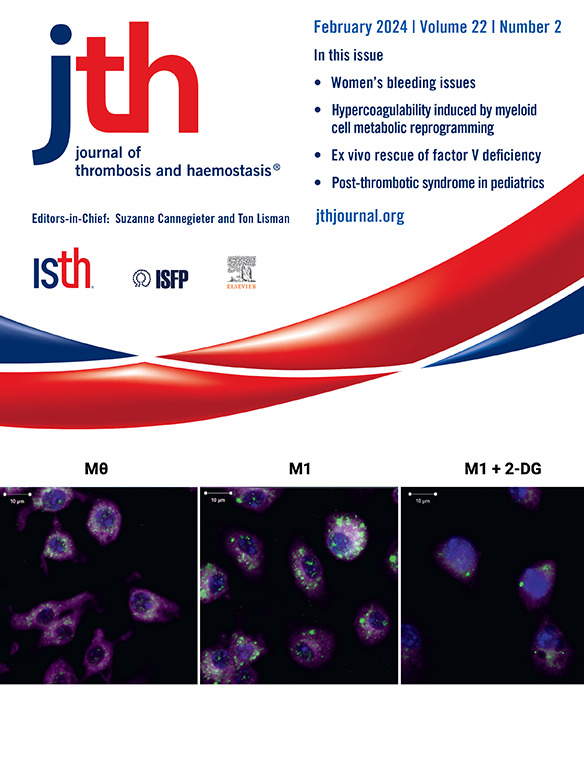133例血栓病筛查阴性患者的下一代测序基因面板策略评估。
IF 5.5
2区 医学
Q1 HEMATOLOGY
引用次数: 0
摘要
背景:虽然静脉血栓栓塞(VTE)的遗传性很高,但只有少数VTE患者的血栓倾向筛查呈阳性。添加罕见变异筛查以确定静脉血栓栓塞缺失遗传性仍需进一步评估。目的:我们报告经过3年应用的小组策略的结果。患者/方法:我们使用高通量测序技术对133名有静脉血栓栓塞病史和血栓病筛查阴性的不相关患者进行了28个与凝血级联和/或静脉血栓栓塞相关的基因测序。结果和结论:我们在46例患者中鉴定出3,4或5类变异,鉴定率为35%。在45个记录的变异中,35个被认为是3类(78%),9个被认为是4类(20%),1个被认为是5类(2%)。四个基因占了鉴定的变异的近三分之二(27/45):serpin1, PROS1, F2和F5。我们观察到serpin1和PROS1基因的高复发变异率,包括Cambridge II (serpin1 p.A416S), Dublin (serpin1 p.V30E)和Heerlen (PROS1 p.S501P)变异。与普通人群相比,这些变异在有症状人群中的频率升高,为它们与静脉血栓栓塞风险的关联提供了强有力的支持。我们在F2中发现了4种(可能的)致病变异:p.R596Q (F2 Belgrade)、p.R541W、p.P386T和p.R425L。本文章由计算机程序翻译,如有差异,请以英文原文为准。
Assessment of a next generation sequencing gene panel strategy in 133 patients with negative thrombophilia screening
Background
Although heritability of venous thromboembolism (VTE) is high, the thrombophilia screening appears to be positive only in a minority of VTE patients. Adding rare variants screening to identify VTE missing heritability still requires further assessment.
Objectives
We report the results of a panel strategy after 3 years of application.
Methods
We performed the sequencing of 28 genes related to coagulation cascade and/or VTE using high-throughput sequencing in133 unrelated patients with a personal history of VTE and negative thrombophilia screening. Only variants with minor allele frequency <0.1% were classified according to the American College of Medical Genetics recommendations. We recorded class 3, 4, and 5 variants.
Results
We identified class 3, 4, or 5 variants in 46 patients resulting in an identification rate of 35%. Out of the 45 recorded variants, 35 were considered as class 3 (78%), 9 were class 4 (20%), and 1 was class 5 (2%). Four genes accounted for nearly two-thirds (27/45) of the identified variants: SERPINC1, PROS1, F2, and F5. We observed a high rate of recurrent variants in the SERPINC1 and PROS1 genes, including the Cambridge II (SERPINC1 p.A416S), Dublin (SERPINC1 p.V30E), and Heerlen (PROS1 p.S501P) variants. The elevated frequency of these variants in a symptomatic population, compared to their frequency in the general population, provides strong support for their association with VTE risk. We identified 4 (likely) pathogenic variants in F2: p.R596Q (F2 Belgrade), p.R541W, p.P386T, and p.R425L.
Conclusion
The high proportion of class 3 variants emphasizes the need for functional studies to better characterize and classify them.
求助全文
通过发布文献求助,成功后即可免费获取论文全文。
去求助
来源期刊
CiteScore
24.30
自引率
3.80%
发文量
321
审稿时长
1 months
期刊介绍:
The Journal of Thrombosis and Haemostasis (JTH) serves as the official journal of the International Society on Thrombosis and Haemostasis. It is dedicated to advancing science related to thrombosis, bleeding disorders, and vascular biology through the dissemination and exchange of information and ideas within the global research community.
Types of Publications:
The journal publishes a variety of content, including:
Original research reports
State-of-the-art reviews
Brief reports
Case reports
Invited commentaries on publications in the Journal
Forum articles
Correspondence
Announcements
Scope of Contributions:
Editors invite contributions from both fundamental and clinical domains. These include:
Basic manuscripts on blood coagulation and fibrinolysis
Studies on proteins and reactions related to thrombosis and haemostasis
Research on blood platelets and their interactions with other biological systems, such as the vessel wall, blood cells, and invading organisms
Clinical manuscripts covering various topics including venous thrombosis, arterial disease, hemophilia, bleeding disorders, and platelet diseases
Clinical manuscripts may encompass etiology, diagnostics, prognosis, prevention, and treatment strategies.

 求助内容:
求助内容: 应助结果提醒方式:
应助结果提醒方式:


